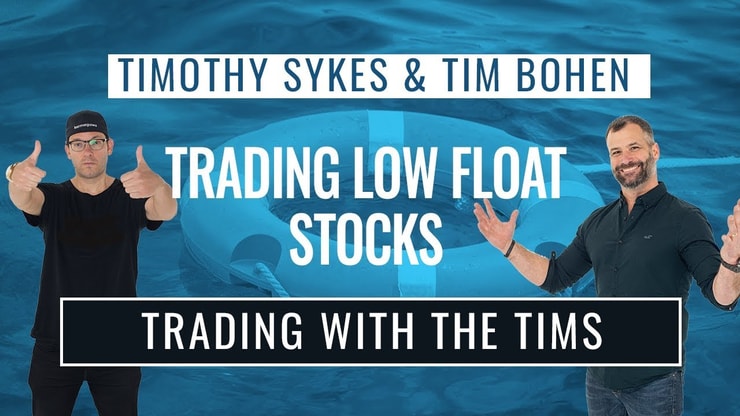Low float stocks typically refer to any stock with fewer than 10 million publicly traded shares. Traders like these stocks because there’s fewer of them, so a smaller level of demand can put pressure on their supply. That means the price can spike quickly.
They can make for amazing penny stock trade setups — if you know what to look for. They’ll often have tons of volatility, which can be both a good and bad thing. It’s up to you to learn to ride the momentum … intelligently.
Trading low float stocks can present a high level of risk. You NEED to know what you’re doing.
What are low float stocks? How you can potentially benefit from trading them, and how do you get started trading low float stocks? Read on for the answers. Plus, I’ll discuss some low float stock screeners.
Table of Contents
- 1 What Are Low Float Stocks?
- 2 What Are Float Shares?
- 3 Why Should You Trade Low Float Stocks?
- 4 Benefits of Trading Low Float Stocks
- 5 2 Key Indicators to Check Before Trading Low Float Stocks
- 6 How to Trade Low Float Stocks in 5 Steps
- 7 Trading Challenge
- 7.1 5 Low Float Stocks to Watch in 2024
- 7.2 Guardforce AI Co., Ltd. (NASDAQ: GFAI) — The Post-Dilution AI Low-Float Stock Supernova
- 7.3 CXApp Inc. (NASDAQ: CXAI) — The Consolidating AI Low-Float Stock Supernova
- 7.4 Cloudweb Inc. (OTCPK: CLOW) — The Pump All-Star Low-Float Stock
- 7.5 Innovative Eyewear Inc. (NASDAQ: LUCY) — The ChatGPT Catalyst Low-Float Stock
- 7.6 WiSA Technologies Inc. (NASDAQ: WISA) — The Reverse-Split Low-Float Stock
- 8 My Favorite Low Float Stock Screener
- 9 The Bottom Line
What Are Low Float Stocks?

2025 Millionaire Media, LLCBefore you can understand stock float, you need to understand shares outstanding.
The term ‘shares outstanding’ refers to all of a company’s shares. That includes restricted shares, which are held by company insiders, execs, and institutional investors. This stock can’t be freely traded.
If you’re looking at a company’s balance sheet, you can find the number of shares outstanding listed by the heading “Capital Stock.” Shares outstanding are a key piece when calculating a company’s market cap and earnings per share (EPS).
Then there’s the float.
The float refers to the number of shares of a stock that are freely available for trading.
Even if a company has a massive amount of shares outstanding, if a lot of them are restricted, everyday traders can’t trade them.
If the number of shares available to trade is fairly low, the stock has a low float.
There isn’t a specific number that denotes a low float. But a lot of traders consider a stock with 10 million shares or less freely available for trading a low float stock.
Confused? Don’t be. Check out this video where I break it down more:
Why Should You Trade Low Float Stocks?
These stocks can move FAST when they trade high volume. They can be great for long-biased traders, as they can have huge gains. Especially if there’s a catalyst and a short squeeze.
Low float stocks can be great for traders with small accounts … if they move in the direction you’re trading.
Benefits of Trading Low Float Stocks
Here’s the thing: these stocks have limited supply. So any catalyst that leads to demand (or lack thereof) can have a larger effect on available shares. The stock moves can be more volatile.
Is this good or bad for traders? Kinda both, actually. It simultaneously raises the risk and potential rewards.
Let’s talk about the risks…
Risks of Low Float Stocks
The volatility with low float stocks means they can make rapid moves up or down.
Since there are limited available shares, news (good or bad) can drastically affect supply and demand.
These stocks are ripe for scammy campaigns like stock pumps and promotions. It’s smart to look at the fundamentals AND do technical analysis. Understand the stocks you trade.
Low floats are more common for micro- or small-cap companies. These companies aren’t as established as large-caps and tend to have more volatility and risk. The low float compounds the risk.
Check out my FREE guide to penny stocks here.
Potential Rewards of Low Float Stocks
The good news? Just about everything that makes these stocks risky can make them potentially rewarding.
Like I said, these stocks can make big moves. As a trader, you have to prepare to grab opportunities. You need to be ready.
News is generally a catalyst for movement in low float stocks. You also need to keep tight watchlists.
2 Key Indicators to Check Before Trading Low Float Stocks

2025 Millionaire Media, LLCTrading is a game of supply and demand.
Float is a supply side metric. The following indicators affect demand…
More Breaking News
- SOFI Stock Surges: Time for a Second Look?
- OSCR Stock Surges: What Now?
- Core Scientific, Inc. Eyes Potential Acquisition by CoreWeave
1.) High Volume
In the stock market, volume equals movement.
Volume is the number of shares of a stock traded during a period of time. It’s based on every transaction — for every buyer, there’s a seller. So every buy and sale aren’t added to the volume separately, but as a single transaction unit.
Volume is an important indicator in technical analysis. It can help you determine a price movement’s strength for a given stock within a time period.
The bigger the volume, the bigger the potential for the overall move — particularly for low float stocks.
2.) News Catalyst
The fact that a stock is low float indicates that there’s a relatively small supply of shares available for trading. This means that the supply and demand can shift on a dime.
So when a juicy news catalyst hits, it can really move the stock in question, causing it to rapidly rise (or fall) in price.
Traders can potentially profit on the way up AND down. It’s a matter of seeing which way the stock is moving and having a solid trading plan.
How can you use the news to your advantage? First, be sure to research the catalyst to see if the news has ‘legs.’ Cut through the BS of self-serving PR statements and find the real scoop yourself.
I use StocksToTrade’s Breaking News Chat. Two former Wall Street pros sift through news and alert members to catalysts that have the most potential to move stocks.
Not all news moves stocks — remember to react, not predict.
Get a 14-day trial to StocksToTrade + Breaking News Chat — only $17!
Also, back it up with research from earnings and the stock’s charts. Look for strong patterns.
A strong catalyst backed up with research can indicate a low float stock trading opportunity.
Be careful — rumors can move stock prices, but you shouldn’t necessarily trust them!
How to Trade Low Float Stocks in 5 Steps
Here are five key steps to help you trade low float stocks.
Want real-life examples? See my approach for trading these stocks and what I look for in potential trades in this video.
Let’s break it down.
#1 Common Stock Patterns and Technical Analysis
When seeking low float penny stocks, do as you would when researching any penny stock: look for common patterns and run technical analysis.
As a trader, I rely more on technical analysis than fundamental analysis.
I trade by patterns, numbers, and proven trends — not on gut instincts or rumors. It keeps things simple and helps me focus.
When it comes to technical analysis, different traders use different tools. You have to find what works for you. Past experience is key.
That’s why I tell my students to study the past. It’s what gives traders hints to future moves — I’m just a glorified history teacher.
Want specific tools? Read more about technical analysis tools here.
#2 Fundamental Analysis
Fundamental analysis is where you look at the company behind the stock and its financials.
I may focus more on technicals…
But I don’t totally skip fundamental analysis. It can be just as important.
Earnings reports can give you valuable insight into how a company handles its finances and debt. You can also read commentary from high-ranking company execs.
To understand fundamental analysis, you need to know a few basics about business finance. Things like operating income and financial statements.
Get familiar with these concepts. You can start with this post.
#3 Create a Low Float Stock List
There are thousands of stocks out there. So how do you determine the top contenders to trade? Your watchlist.
Need a starting point? You might consider using the method of one of my most successful students, Tim Grittani.
He might start with a list of stocks that are up 5% for the day, trading around 10 million in volume. This list might include five stocks or 20. It depends on the time of day and the market.
From there, he goes through every stock on the list and looks at the daily charts for patterns. He’s looking for the strongest contenders.
It’s a good habit to follow. It’s how you can narrow down your choices to the best stocks for your strategy.
Having trouble with your watchlist? Answer the following:
- Which patterns have you had the most success with? (Don’t know? You need this.)
- Where’s the most volatility (and potential)?
- Which way is the stock gapping premarket?
#4 Look For Low Float Stocks With High Volume
Always look at volume. Especially with low float stocks.
With the lower supply in low float stocks, volume can be a powerful indicator for price action.
If you don’t have enough volume, you can get stuck in a trade. Don’t be that trader.
#5 Keep on Learning
Repeat after me: I will never stop learning.
As long as you trade, you must be committed to learning.
The market’s not static. If you want a long-term trading career, you need to continue to change and adapt. You need to put in the work, and refine your methods over time.
You may find a setup that works over and over. But then one day, it stops working. That’s how the market works.
Trading Challenge

2025 Millionaire Media, LLCWant to kickstart your education and avoid common trading mistakes? Consider applying for my Trading Challenge.
You’ll learn from me and my top students — and have access to an amazing trading community.
You’ll also get access to resources like webinars, DVDs, and my personal watchlists. You can learn from my techniques and adapt them to suit your trading style.
I teach so I can give my students the knowledge I never had when I started out. It’s how I pay it forward and help others realize their trading potential.
5 Low Float Stocks to Watch in 2024
My low-float stock picks for 2024 are:
- (NASDAQ: GFAI) — Guardforce AI Co., Ltd. — The Post-Dilution AI Low-Float Stock Supernova
- (NASDAQ: CXAI) — CXApp Inc. — The Consolidating AI Low-Float Stock Supernova
- (OTCPK: CLOW) — Cloudweb Inc. — The Pump All-Star Low-Float Stock
- (NASDAQ: LUCY) — Innovative Eyewear Inc. — The ChatGPT Catalyst Low-Float Stock
- (NASDAQ: WISA) — WiSA Technologies Inc. — The Reverse-Split Low-Float Stock
These stocks have a low float and had a run-up in 2024. Check these out so you can see the potential and prepare.
Please note: I’m only watching these stocks. I won’t trade them unless they fit my preferred setups.
The best traders watch more than they trade. That’s what I’m trying to model here. Pay attention to the work that goes in, not the picks that come out.
If you want to see more NO-COST watchlists, you can sign up for my weekly watchlist here.
Guardforce AI Co., Ltd. (NASDAQ: GFAI) — The Post-Dilution AI Low-Float Stock Supernova
My first low-float stock pick is Guardforce AI Co., Ltd. (NASDAQ: GFAI).
What do you get when you combine a hot sector with a low float?
That’s right — a former supernova!
The artificial intelligence industry is pretty green, but that hasn’t stopped reports from suggesting that it could replace up to 300 million jobs by 2030.
AI robots are already popping up in the business world — be it software integration or good, old-fashioned in-store assistance.
When a sector is making news, its stocks tend to spike more easily. I like to keep these stocks on my watchlist.
Why I Like It
GFAI is all too familiar with spiking. And when it spikes, it tends to go big.
We saw a spike of over 660% in April, for example.
Its run stopped because of TWO share offerings in May… That diluted its float, making existing shares less valuable.
I’m still watching it though. Even with the dilution, GFAI’s float is still under 5 million shares.
One important element of trading is keeping a close eye on past spikers. If it spiked once, it can spike again.
Add the fact that AI stocks are trending, and you’ve got yourself a solid setup for future spikes.
CXApp Inc. (NASDAQ: CXAI) — The Consolidating AI Low-Float Stock Supernova
My second low-float stock pick is CXApp Inc. (NASDAQ: CXAI).
CXAI uses AI software to simplify hybrid work for companies.
With the release of ChatGPT taking the internet by storm, CXAI was able to ride the waves of the AI frenzy.
Compared to GFAI, CXAI takes the cake, launching over 1,400% in April.
Its float is even smaller than GFAI’s. It’s a tiny 1.7 million shares.
Unlike GFAI, it didn’t dilute its shares. That’s part of the reason it’s still hanging around close to its highs.
Why I Like It
You can see from the chart that CXAI has a strong base of support. Its awesome run in mid-April hit resistance and then trended down. But it managed to bounce on April 24, going for another run…
Since then, it hasn’t dipped below its April 24th lows. That’s called support. This video will give you some insight into why that’s important:
There’s a chance that the price will bounce upwards again, making it ripe for a possible trade.
Cloudweb Inc. (OTCPK: CLOW) — The Pump All-Star Low-Float Stock
My third low-float stock pick is Cloudweb Inc. (OTCPK: CLOW).
I can’t say this enough — past spikers often spike again.
That’s why CLOW has been on my radar since I first traded it in September 2018. I’ve made a total of $4,404 trading this stock (click the link to see my individual trades).
The stock launched more than 860% in 2018. And then it imploded, waiting for its next pump.
This is one of those crappy penny stocks that follows my 7-step penny stocking framework to the letter:
For this reason, CLOW is one of those big spikers worth keeping on my watchlist.
Why I Like It
CLOW’s chart looks quiet… But its volume spiked significantly on April 24th.
That day and the next, it traded nearly 3 million shares… Not bad for a stock with a 2.5 million share float!
I traded it for small gains on the 24th. I made $365 trading this sketchy stock VERY conservatively (starting stake $4,475). The volume started drying up so I played it safe.
I think it’s a good idea to stay tuned to this website hosting and cloud data storage company.
Innovative Eyewear Inc. (NASDAQ: LUCY) — The ChatGPT Catalyst Low-Float Stock
My fourth low-float stock pick is Innovative Eyewear Inc. (NASDAQ: LUCY).
LUCY has just 2.5 million shares in its float. Add AI to the mix, and we have the perfect recipe for potential spikes.
Why I Like It
This eyewear brand is developing ChatGPT-enabled smart glasses. This chatbot is THE BEST catalyst in the market’s hottest sector.
After the news dropped, LUCY spiked by over 270%.
It’s come down to earth since then. But I think there might be more steam ahead for this stock.
WiSA Technologies Inc. (NASDAQ: WISA) — The Reverse-Split Low-Float Stock
My fifth low-float stock pick is WiSA Technologies Inc. (NASDAQ: WISA).
I made $570 in total earnings trading WISA (click the link to see my individual trades). That was after WISA did a 1-for-100 reverse split…
This lower, consolidated supply translates to a low-float stock with increased share prices. It’s a bit of a fakeout though — the only reason it did this reverse split is to avoid falling out of compliance with Nasdaq’s $1 per share minimum requirement.
We saw a slight bump in January in response to the reverse split before it dipped back downward. But I’m keeping my eye on WISA because of the next piece of the puzzle…
Why I Like It
In May, the wireless sound tech company announced its plan to acquire Comhear — an AI-based audio company.
This kind of news can spike a low-float stock, no matter how it achieved its low-float status.
We saw a 70% gain right after the announcement.
As of this writing, it’s given back most of this spike. But trading is a game of patience, and I’m watching to see what else is in store for this stock.
My Favorite Low Float Stock Screener

2025 Millionaire Media, LLCHere are some of my go-to resources…
StocksToTrade
I helped design the StocksToTrade platform for screening AND trading. It’s designed for the low float and low-priced stocks I like to trade. You can use StocksToTrade to scan for low floats, and the float displays in charts, watchlists, and more.
I use this tool every day. Get your 14-day trial here — only $7!
How to Find Low Float Stocks on thinkorswim
TD Ameritrade’s thinkorswim is another common trading platform, but it doesn’t come with a built-in scan for stock float.
You’d have to invest in an add-on or do your own research. But once you find low float stocks, this platform has plenty of tools for further analysis.
How to Find Low Float Stocks on Finviz
Finviz is a free website for stock info and news. It has a free built-in screener, which works for float size. This can be a good tool for beginners.
The Bottom Line
Low float stocks can provide many opportunities for traders. But remember, they come with a higher level of inherent risk. It’s important to do plenty of research on potential plays before executing trades.
Make the most of screening tools, charts, and fundamental and technical analysis. Focus on the process and executing educated trades.
How does the float play into your trades? Leave a comment below and let me know!











Leave a reply